Ready to transform your garage from a dimly lit storage space into a well-lit, functional, and inviting area? This comprehensive guide explores 23 garage lighting ideas, covering everything from practical shop lights to stylish architectural lighting.
Whether you’re a DIY enthusiast, a car aficionado, or simply looking to improve your garage’s design and ambiance, you’ll find inspiration and expert advice to illuminate your space effectively. Discover the perfect blend of style, functionality, and energy efficiency for a practical, visually appealing, well-lit garage.
10 Overhead Indoor Garage Lighting Ideas
A well-lit garage starts with the right overhead lighting. Here are some popular options to consider:
#1. Shop Lights
The classic single-bar fluorescent shop light remains popular for garages due to its affordability and ease of installation. These fixtures are available in various lengths (typically 2’ or 4’) and can accommodate fluorescent and LED tubes.
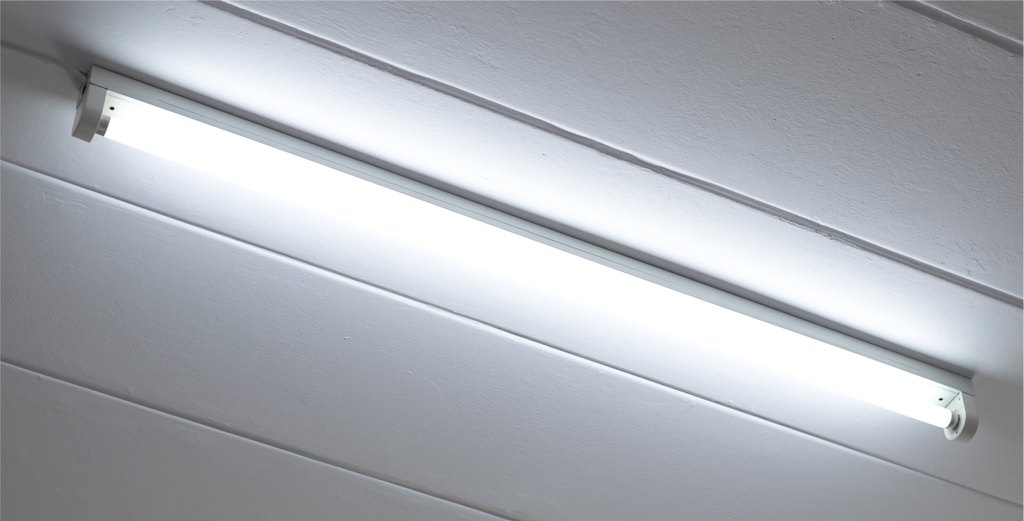
While they offer decent light spread and lifespan, they can sometimes feel a bit utilitarian in appearance.
Pros
Cons
#2. Flush Mount Ceiling Lights
Flush mount lights are a great option for garages with low ceilings. You install them directly against the ceiling, maximizing headroom.
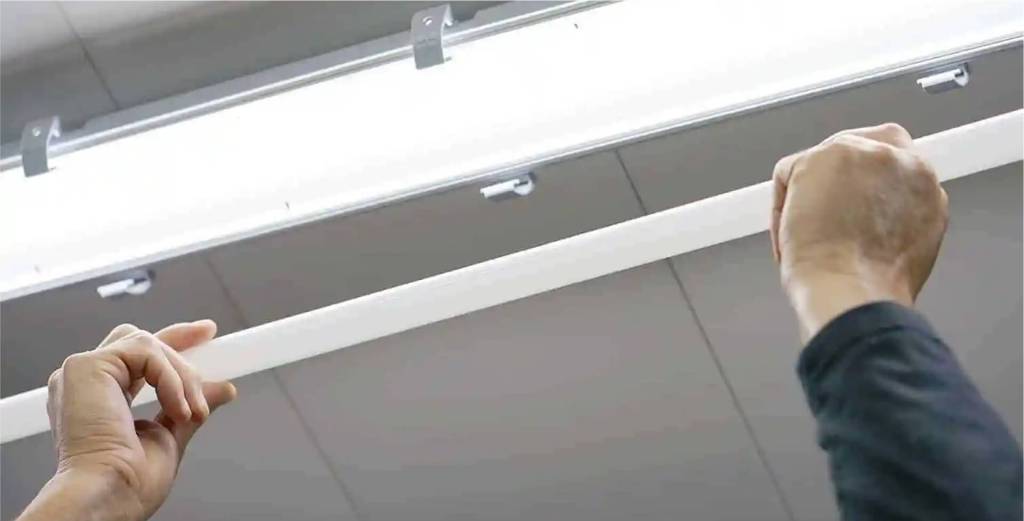
These fixtures are unobtrusive, come in various styles, from classic to modern, and can accommodate different bulb types. While they offer versatility and space-saving design, the light spread can be inconsistent depending on the fixture. They’re also a good choice for shed lighting.
Pros
Cons
#3. LED High Bay Lights / Low Bay Lights
High bay lights are designed for garages with very high ceilings (20’ or more), while low bay lights are suitable for ceilings between 12′ and 20′. These fixtures provide bright, even illumination using reflectors and precise angles to maximize light distribution.
They’re energy-efficient and long-lasting, ideal for large, open garages or workshops. While they’re not a fit for every residential garage, they’re a good option for pole barns and auto shops with tall hydraulic lifts.
Pros
Cons
#4. Recessed Lights
Recessed lights, also known as canned lights, offer a sleek and modern look. The fixtures are embedded into the ceiling so they’re hidden and don’t stick out, creating a clean, minimalist aesthetic.

While they save space and offer a polished appearance, they typically have a narrow light spread and might not be enough as the sole illumination source.
Pros
Cons
#5. Wraparound Lights
Wraparound lights are another space-saving solution that installs level with the ceiling for maximum vertical space. They’re similar to flush-mount recessed lights but feature a wraparound shade that directs light in multiple directions. This design improves visibility and light spread compared to traditional flush mounts.

Wraparounds are readily available, relatively inexpensive, and offer good light performance for garage work.
Pros
Cons
#6. Track Lighting
Track lighting offers versatility and focused illumination. It consists of a track that can fit multiple adjustable light heads, and you can point to where light is needed most.
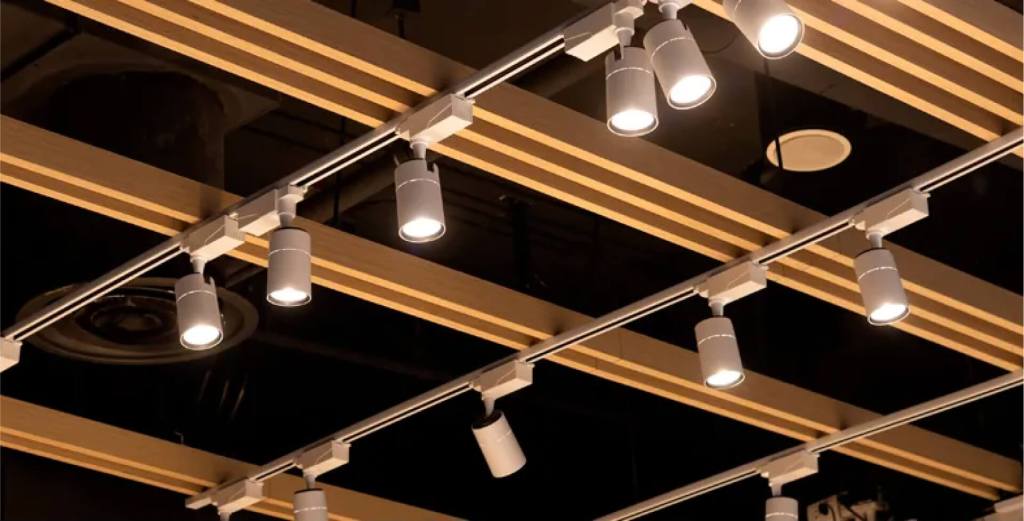
This is ideal for highlighting work areas, artwork, or specific features in your garage.
Pros
Cons
#7. Hexagon Ceiling Grid with LED Panels
Consider a hexagon ceiling grid with LED panels for a modern, visually striking look.
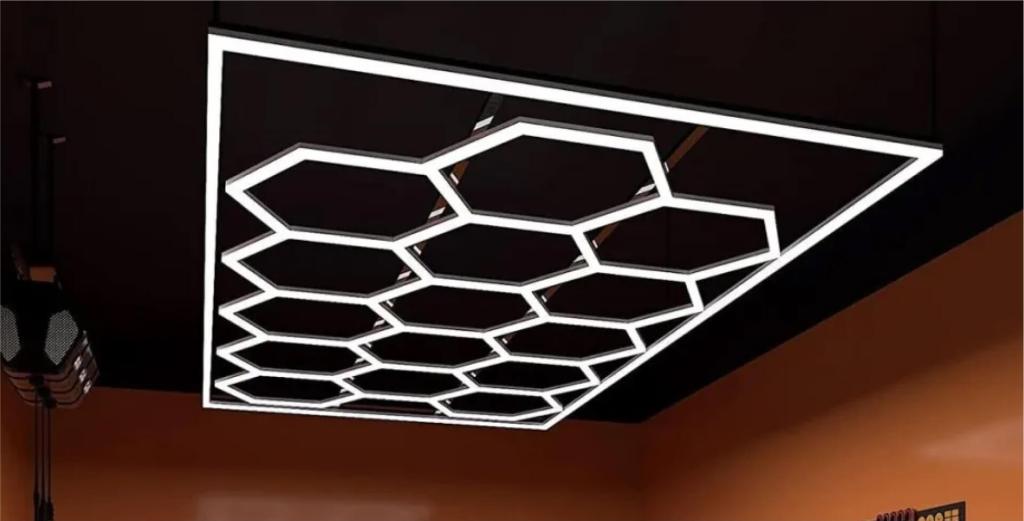
These grids create a geometric pattern on your ceiling, with each hexagon containing an LED light source. They offer bright, even illumination and a unique design element.
Pros
Cons
#8. Recessed Track Lighting
This option combines the sleekness of recessed lighting with the versatility of track lighting. The track is recessed into the ceiling, creating a clean and minimalist look, while the adjustable heads let you direct light where needed, just like any normal track light does.
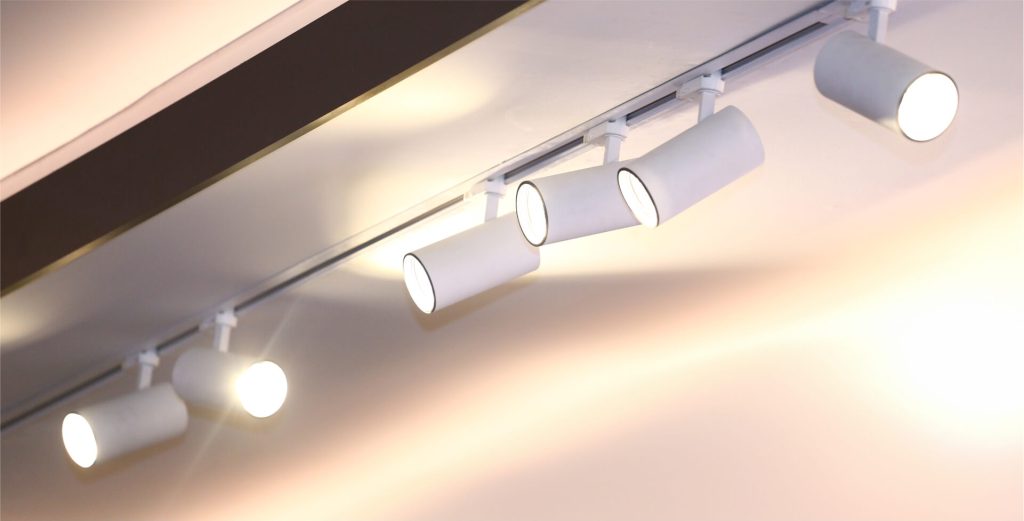
Pros
Cons
#9. Cove Lighting
Cove lighting involves installing garage lights in a ledge or recess along the perimeter of the ceiling. This location creates an indirect, ambient light that washes the ceiling and adds a soft, diffused glow.
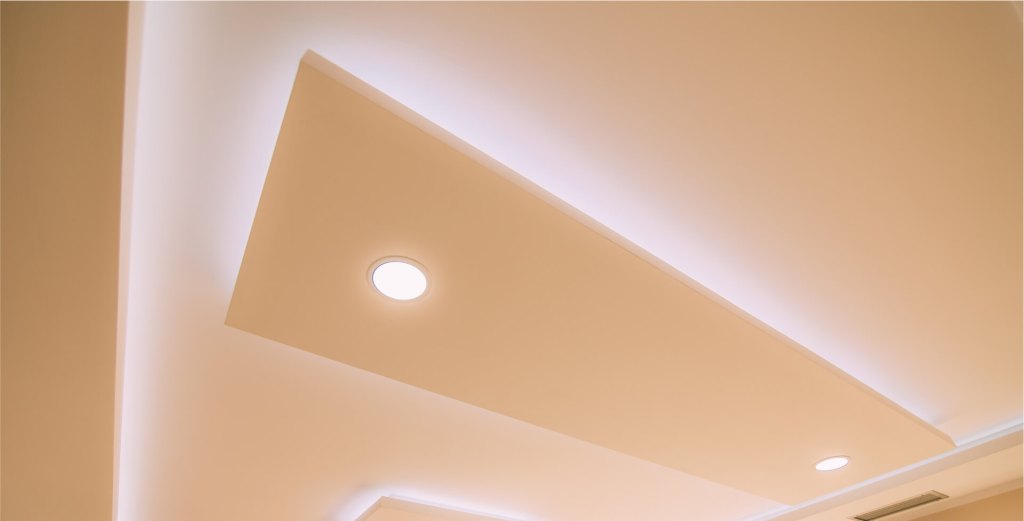
While it makes the garage look more sophisticated and stylish, cove lighting requires a specially designed and built ceiling with the required recesses or ledges. This requirement makes it a more complex and expensive lighting setup.
Pros
Cons
#10. Ceiling Recessed LED Strip Lighting
Similar to cove lighting, this involves recessing LED strip lights into the ceiling. The difference is that these LED strips provide direct light flush from the ceiling instead of being hidden in a cove and providing indirect light.

The result is a clean, modern look with even light distribution. LED strip lights are energy-efficient and offer a wide range of color options.
Pros
Cons
2 Garage Wall Lighting Ideas
Don’t forget about your garage walls! Wall lighting can provide essential task lighting, accentuate features, and enhance your garage’s ambiance.
#11. Wall Sconces
Wall sconces are a stylish and practical option for garage walls. They come in various modern and traditional designs, providing ambient or task lighting. Consider installing sconces near entryways and workbenches or using them to highlight architectural details.
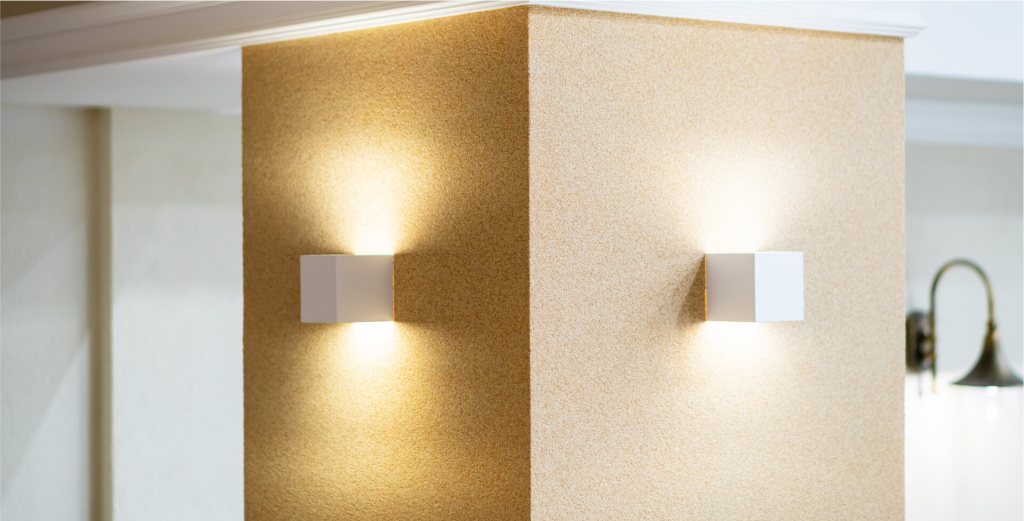
Pros
Cons
#12. Wall-Mounted Task Lights
For focused illumination in specific work areas, wall-mounted task lights are a great choice.

These lights often feature adjustable arms or swivel heads you can point to wherever you need. They are ideal for workbenches, tool storage areas, or hobby stations.
Pros
Cons
2 Garage Door Lighting Ideas
Properly lighting your garage door area is crucial for safety and security, especially at night. Here are a few ways to illuminate this important zone.
#13. Garage Door Opener Lights
Many modern garage door openers come equipped with built-in lights. These lights automatically turn on when the door is activated, providing illumination as you enter or exit the garage. They offer convenience and enhance safety by increasing visibility.
Pros
Cons
#14. Garage Door Panel Lighting
Consider installing lights directly on the garage door panels for a more integrated look.
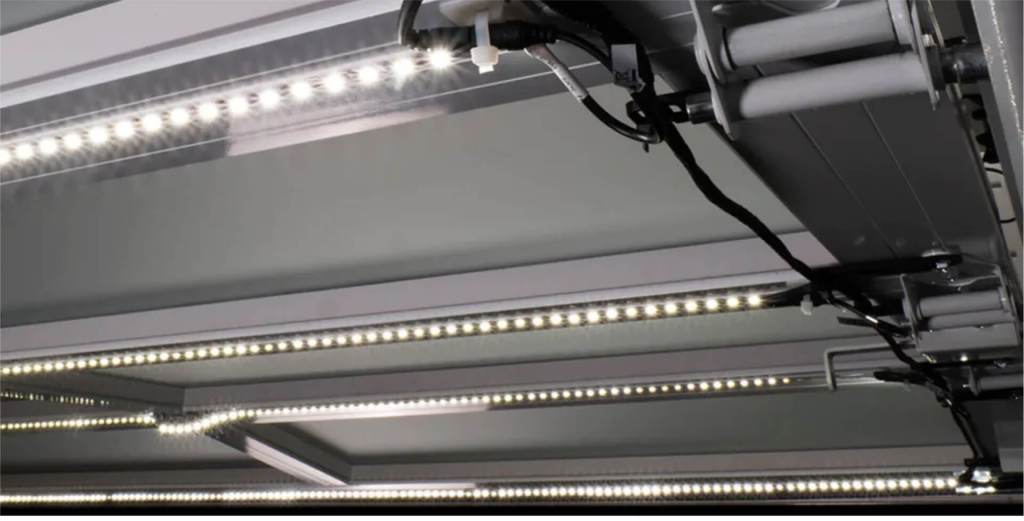
Some options include LED strip lights that adhere to the panels or small fixtures that attach to the hinges. Both create a unique visual effect and provide illumination inside and outside the garage when the door is open.
Pros
Cons
4 Exterior Garage Lighting Ideas
Extend your lighting design beyond the garage interior to enhance safety, security, and curb appeal.
#15. Outdoor Barn Lights
Barn lights are a popular choice for garage exteriors. They offer a classic, rustic aesthetic and provide ample illumination. Consider installing them on either side of the garage door or above entryways.
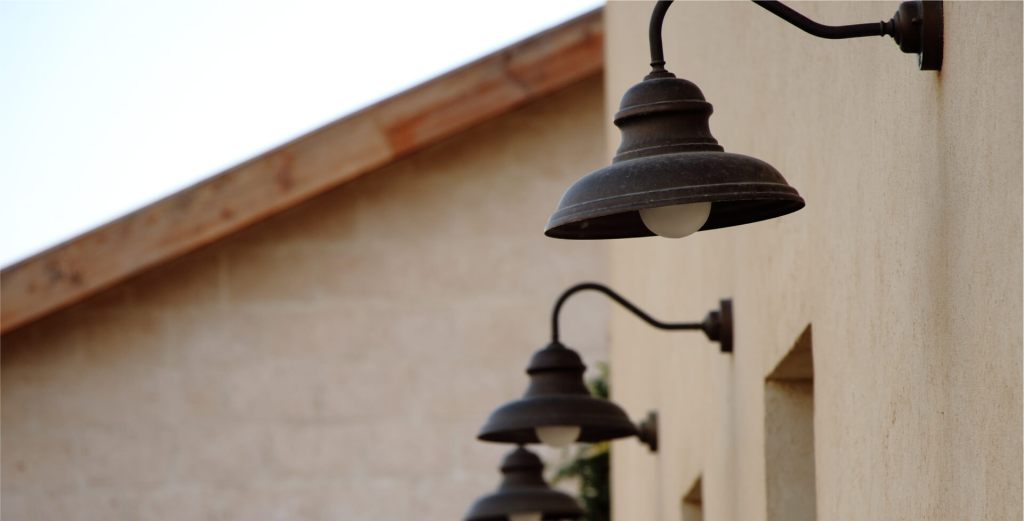
Pros
Cons
#16. Floodlights
For bright, widespread illumination, floodlights are a reliable option. They’re often used for security, as they can deter intruders and illuminate dark areas around the garage.

Pros
Cons
#17. Motion-Sensing Security Lights
Motion-sensing lights offer a combination of security and energy efficiency.
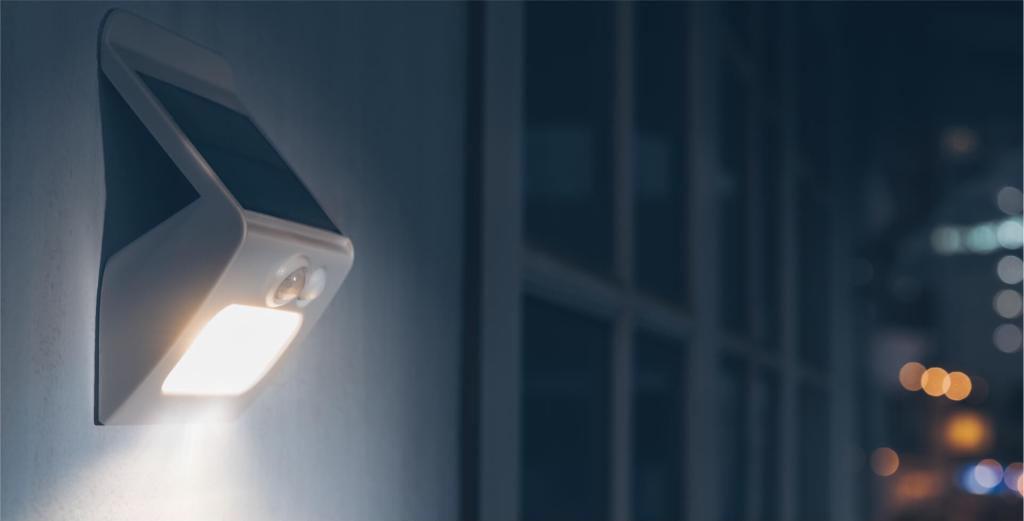
They automatically turn on when they detect movement, providing illumination only when needed. This automation is ideal for deterring intruders and increasing safety around the garage.
Pros
Cons
#18. Solar-Powered Outdoor Lights
For an eco-friendly option, consider solar-powered outdoor lights. These lights harness the power of the sun to charge during the day and provide illumination at night. They are easy to install and require no wiring.
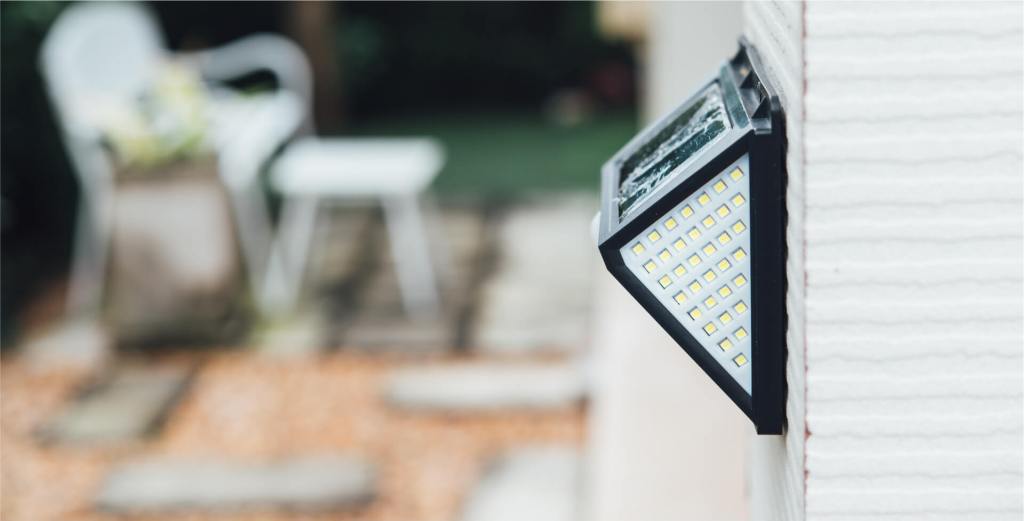
Pros
Cons
While we’ve covered the main categories of garage lighting, here are a few more ideas to consider:
#19. Natural Light
Natural light won’t help you work after dark, but it has many health benefits and is easy on your wallet (Source: Journal of Affective Disorders). A large skylight, garage windows, or even a translucent garage door can flood your space with soft sunlight, allowing you to see the details of your project without harsh artificial light.
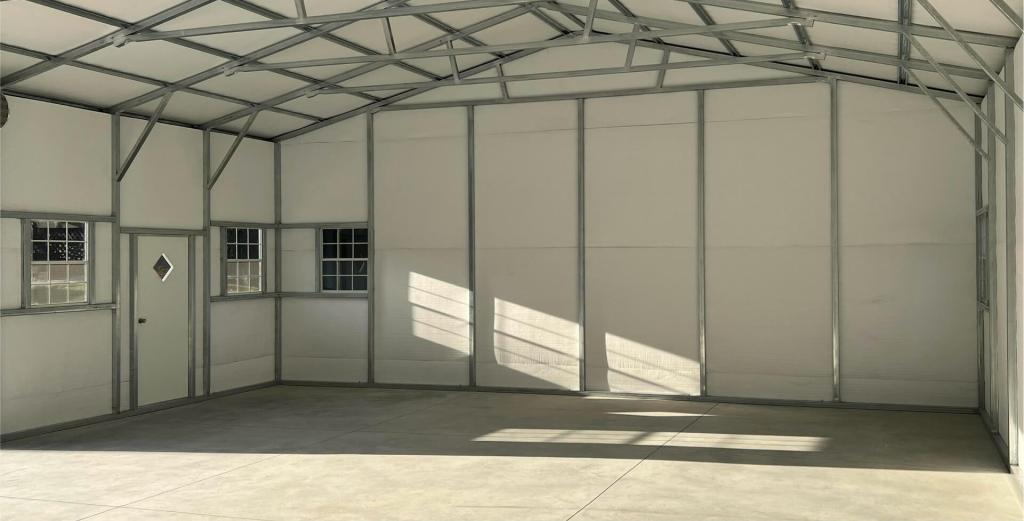
Natural light is a nice touch for your garage design, too. Choose light-colored walls and ceilings to reflect light and improve visibility throughout your garage.
Pros
Cons
#20. Workbench Lights
Workbench lights are mounted near a workspace to provide direct light essential for detailed tasks and hobbies. They come in several wattages, bulb types, and styles, including clamp-mount fixtures, under-cabinet flush lights, or wall-mounted fixtures.

Options include adjustable arm lamps, under-cabinet lights, and LED strip lights. They’re extremely versatile to meet your space’s different needs, though they won’t light your whole garage.
Pros
Cons
#21. Portable Work Lights
Work lights are mobile fixtures, often with a telescoping stand, that can pivot to direct light where needed most. They’re usually wired and include a hook or handle to fit on a stand, hang from a workbench, or sit by themselves.

They’re super adaptable and are available in cool-to-the-touch LED bulbs as well as traditional tungsten and halogen bulbs.
Pros
Cons
#22. Architectural Integrated Linear Lighting
For a sophisticated and modern look, consider integrated linear lighting. This option involves embedding LED strip lights or linear fixtures into the architectural features of your garage, such as the walls, ceiling, or even the floor. It creates a seamless and visually striking effect.
Pros
Cons
#23. Smart Lighting for Garages
Smart lighting allows you to control your garage lights remotely using your smartphone or voice commands. You can schedule lights to turn on and off, adjust brightness, and even change colors. Smart bulbs offer convenience, energy efficiency, and enhanced security.
Pros
Cons
Best Bulbs for Your Garage
Garage light fixtures come in various designs and fit different light bulbs. Your choice of light bulbs is as important as selecting the right fixtures. Here’s a breakdown of the most common types:
Bulb Type
Pros
Cons
LED
Energy-efficient, long-lasting, durable, cool to the touch
Higher upfront cost
CFL
More energy-efficient than incandescent, relatively affordable
It contains mercury, can be slow to warm up
Halogen
Bright white light, dimmable
Less efficient than LEDs and CFLs, it generates heat
Incandescent
Inexpensive, warm light
Least energy-efficient, short lifespan, generates heat
Source: Department of Energy
LED Garage Lighting
LEDs are available everywhere and are growing in popularity for their high efficiency (reducing energy costs) and extremely bright light. They’re highly energy-efficient and offer lifespans exceeding 25 years.
Furthermore, LEDs stay cool to the touch and can produce a variety of colors in different intensities, so there’s an LED bulb for nearly any outdoor or indoor lighting need.
Fluorescent Lights
Fluorescent lights are exceptionally bright, which made them a go-to for lighting commercial spaces for decades. Most people recognize these tube lights from grocery stores, hospitals, and schools.
They’re more energy-efficient than incandescent or halogen bulbs and more affordable than LEDs, so they’re also popular in residential garages. Fluorescent lights have a reputation for being harsh and can aggravate some medical issues, including migraine headaches, so they’re not for everyone.
Halogen Lights
Halogen bulbs have shorter lifespans than other popular bulbs, but their bright daylight color and dimmable design remain popular. The biggest drawback is that they produce lots of heat, which can become a fire hazard or personal safety concern in tight spaces.
Incandescent Lights
Incandescent bulbs are commonly used in interior lighting because they produce a warm, gentle glow.
They’re not as long-lasting or energy-efficient as other bulbs, but they’re dirt cheap and compatible with many fixtures.
Since they’re not super bright and only last about a year, they’re not the best fit for many garage applications. But they work well with a lamp or ceiling fixture if you just need a little bit of light.
Choosing the Right Color Temperature
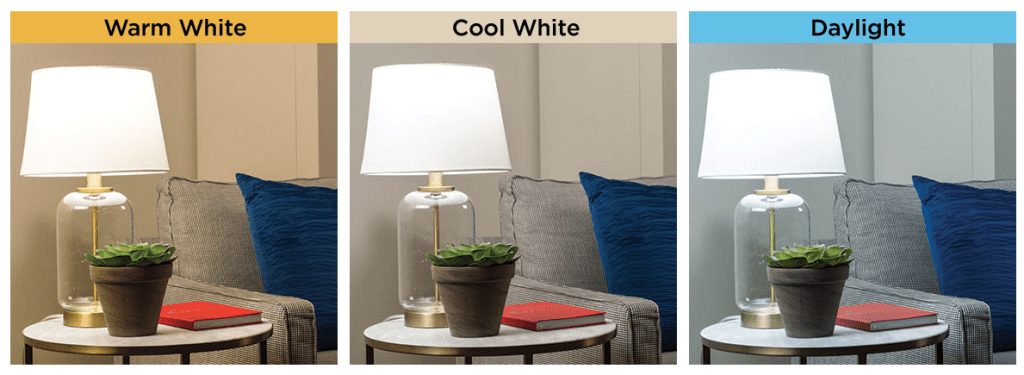
Color temperature plays a significant role in how your garage looks and feels. Measured in Kelvin (K), color temperature affects the ambiance and visibility of your space. Here’s a quick guide:
| Color Temperature | Kelvin (K) | Description | Best For |
|---|---|---|---|
| Warm White | 2,700K – 3,000K | Cozy and inviting | Relaxing, socializing |
| Soft White/Neutral White | 3,500K – 4,100K | Balanced and natural | General use, most tasks |
| Cool White/Daylight | 5,000K – 6,500K | Crisp and invigorating | Detailed work, hobbies, maximum visibility |
Source: Westinghouse
When selecting color temperatures, consider the primary function of your garage and the mood you want to create. A combination of different color temperatures might be the best solution for a multipurpose garage.
Energy Efficiency in Garage Lighting
With growing concerns about energy consumption and environmental impact, it’s essential to consider efficiency when choosing a garage lighting option. Efficiency is measured in lumens per watt (lm/W). This value tells you how much light (lumens) a light bulb produces for every watt of power it consumes.
The higher the lm/W, the more efficient the bulb.
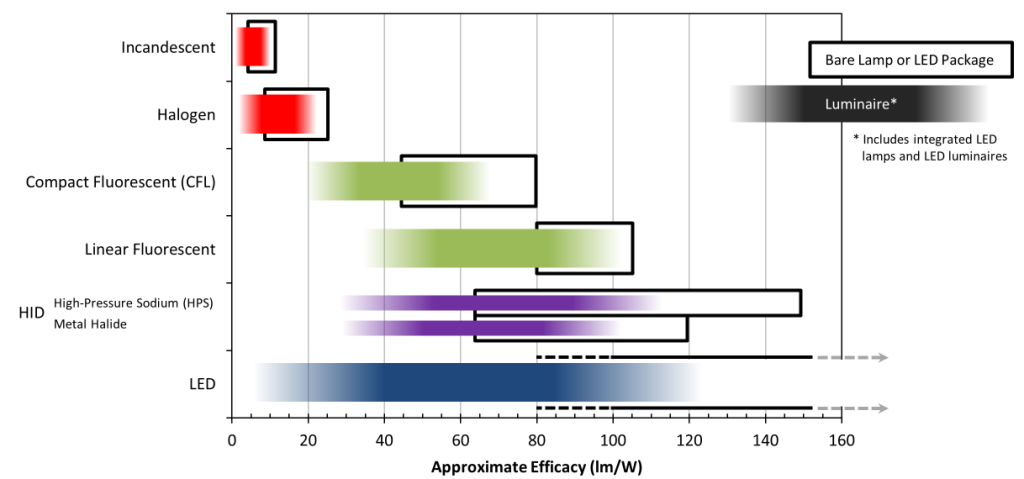
Why is efficiency important?
- Lower energy bills
- Reduced carbon footprint
- Less frequent replacements
Here’s a comparison of different bulb types to help you make informed choices:
| Bulb Type | Efficiency (lm/W)1 | Lifespan2 |
|---|---|---|
| LED | 80–160+ | 40,000–50,000 hours |
| CFL | 80–105 | 8,000–20,000 hours |
| Halogen | 10–25 | 2,000–4,000 hours |
| Incandescent | 5–15 | 750–2,000 hours |
Sources: 1PennState College; 2Bulbs.com
Tips for an Effective Garage Lighting Layout
A well-planned lighting layout is essential for a functional and enjoyable garage. This section will guide you through the key considerations for creating a garage lighting scheme that meets your specific needs.
General Lighting Layout Tips
Start by considering your garage’s overall illumination. For general lighting, aim for even coverage without dark spots.
The spacing and placement of your light fixtures will depend on your garage’s square footage and shape, as well as the ceiling height.
A common rule of thumb is to space overhead fixtures 4 to 6 feet apart. In larger garages, you might need a combination of overhead fixtures and supplemental lighting to ensure adequate brightness.
Zoning
Divide your garage into zones based on how you use the space. For example, you might have a dedicated workbench area, a parking zone, and a storage zone.
Install separate switches for each zone so you can control the lighting independently. Doing so allows you to illuminate only the areas you’re using.
Layering
Combine different types of lighting to create a balanced and versatile space.
- Accent lighting highlights specific features or adds a decorative touch.
- Task lighting focuses brighter light on work areas.
- Ambient lighting provides overall illumination.
Task Lighting Placement
Position task lighting strategically to minimize shadows and eye strain. For workbenches, consider under-cabinet lighting, adjustable arm lamps, or LED strip lights to provide focused illumination.
Enjoy a Custom Garage
A custom garage designed for your work is the dream of any tradesperson or creative. From your ideal ceiling height and roof style to illuminating garage lighting ideas, use our 3D Builder to customize a garage to your specifications today!




